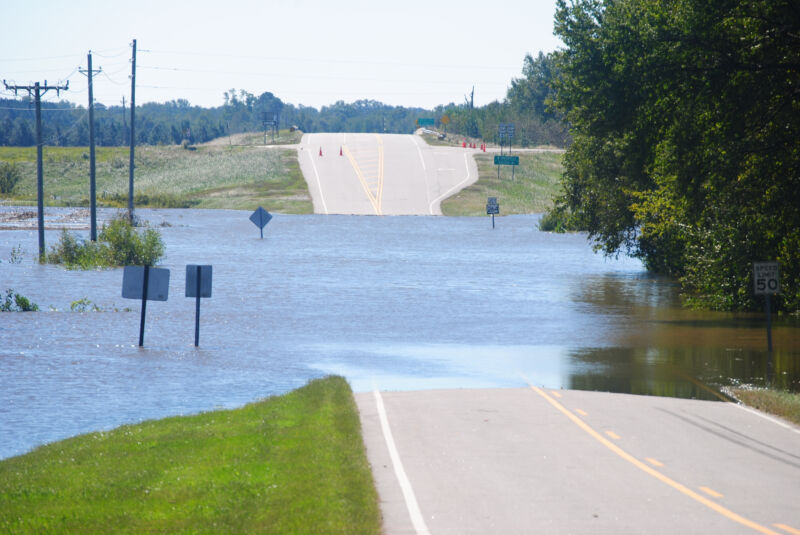
Climate change produces lots of risks that are difficult to predict. While it will make some events—heatwaves, droughts, extreme storms, etc.—more probable, all of those events depend heavily on year-to-year variation in the weather. So, while the odds may go up, it’s impossible to know when one of these events will strike a given location.
In contrast, sea level rise seems far simpler. While there’s still uncertainty about just how quickly ocean levels will rise, other aspects seem pretty predictable. Given a predicted rate of sea level rise, it’s easy to tell when a site will start ending up underwater. And that sort of analysis has been done for various regions.
But having a property above water won’t be much good if flooding nearby means you can’t get to a hospital or grocery store when you need to or lose access to electricity or other services. It’s entirely possible for rising seas to leave a property high, dry, but uninhabitable as rising seas cut connections to essential services. A group of researchers has analyzed the risk of isolation driven by sea level rise, and shows it’s a major contributor to the future risks the US faces.
Off-site risks
Conceptually, isolation is pretty easy to understand. While some people on the coast may live on relatively high ground, access to their homes can involve a road that goes through low-lying areas. As such, sea level rise can mean people living there start to lose road access due to flooding at high tide long before any ocean shows up on the property. While things like trips for groceries can be planned around tidal flooding, access to things like schools and emergency services typically can’t be planned around the tides.
Inundation of roads can also weaken their foundations, leading to failure or maintenance that can take them out of use. Finally, we often run critical infrastructure—water and sewer lines, electricity, networking—along roadways. So there are various ways that losing road access, even from periodic flooding, can make living somewhere untenable.
To find out how significant this sort of isolation could be, a team of researchers (Tom Logan and Mitchell Anderson from the University of Canterbury in New Zealand, and Allison Reilly of the University of Maryland) used OpenStreetMap to track every street in the US’s 48 contiguous states and compared them to sea level rise projections developed by the National Oceanographic and Atmospheric Administration. Using three scenarios for future ocean levels (0.5, 1.0, and 2.0 meters of rise by the end of the century), they tracked every neighborhood’s access to its nearest essential facility, such as a public school or fire station, determining when intervening roads were going to be flooded during high tides.
While this is inexact, it reasonably indicates when transit to and from a neighborhood starts to become impractical. This doesn’t mean the ocean completely cuts off the road, but it does mean that flooding will be a regular issue.
The bad news is that there’s no good news
The results make it clear that isolation will be a significant problem for the US. Even under the lowest sea level rise scenario (0.5 meters by 2100), over half a million people will be at risk of isolation in 2080—and that’s in addition to the people whose property will be regularly inundated. Under the intermediate scenario, that number rises to nearly a million people.
There were several ways to view the added risk. For some neighborhoods, for example, isolation will occur at ocean levels two meters below what’s needed to flood the area. The risk of isolation is also accelerated compared to inundation; some neighborhoods that won’t see floods until 2060 will end up isolated as early as 2030 under the rapid sea level rise scenario. And the researchers estimate that 4 million residents would be at risk of isolation in neighborhoods that would remain above water even under the high sea level rise scenario.
These risks are also spread unevenly. For example, the risk of isolation is higher in Maine than in Florida, although Florida’s larger population means that more people would be at risk.
Regardless of the details, however, the work makes it clear that there’s far more at risk than individual property from sea level rise and that many places will become far less livable long before the water starts lapping at doors. On the positive side, there are indications that some states are focused on preserving essential infrastructure. But it’s unclear whether that sort of foresight has become part of the considerations for homeowners and property developers.
If you’re interested in comparing the risk of isolation to that of inundation, the researchers have built a website that lets you explore the risks under different sea level rise scenarios.
Nature Climate Change, 2023. DOI: 10.1038/s41558-023-01642-3 (About DOIs).
https://arstechnica.com/?p=1926888

